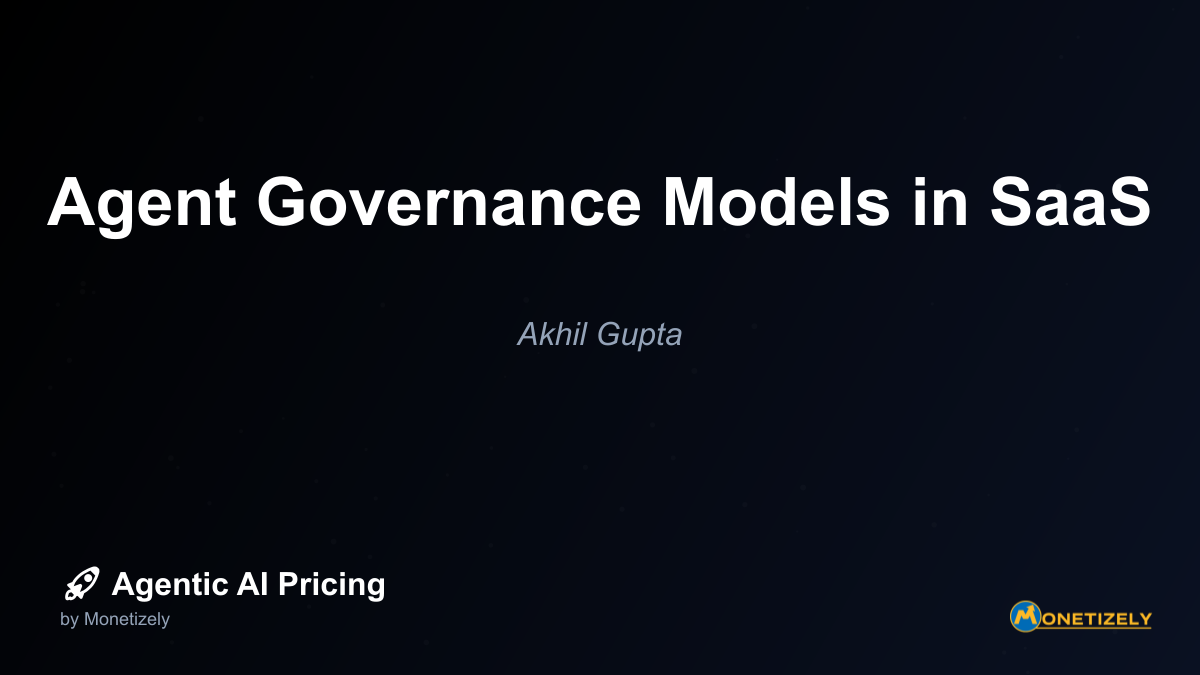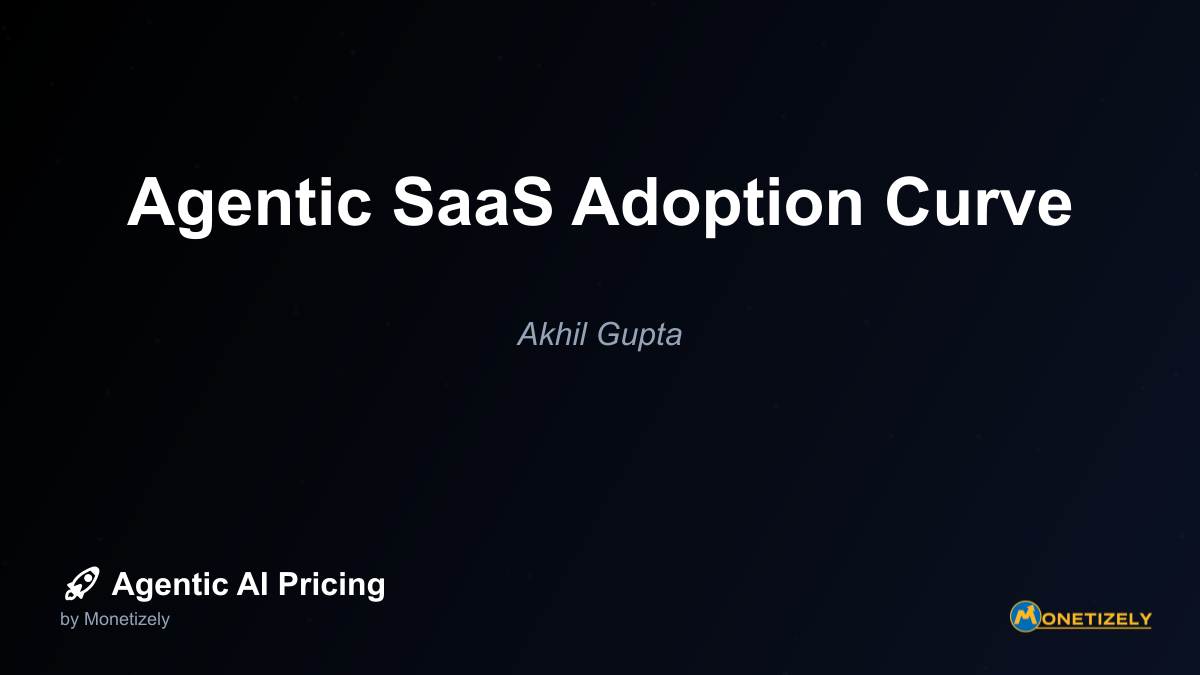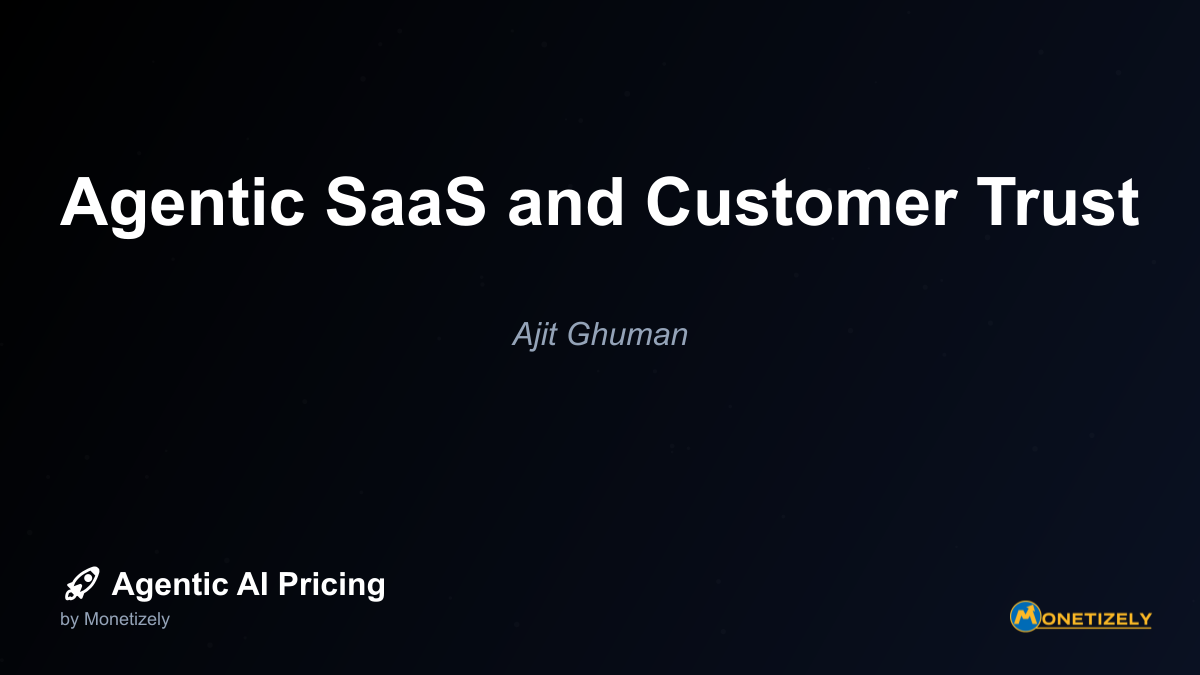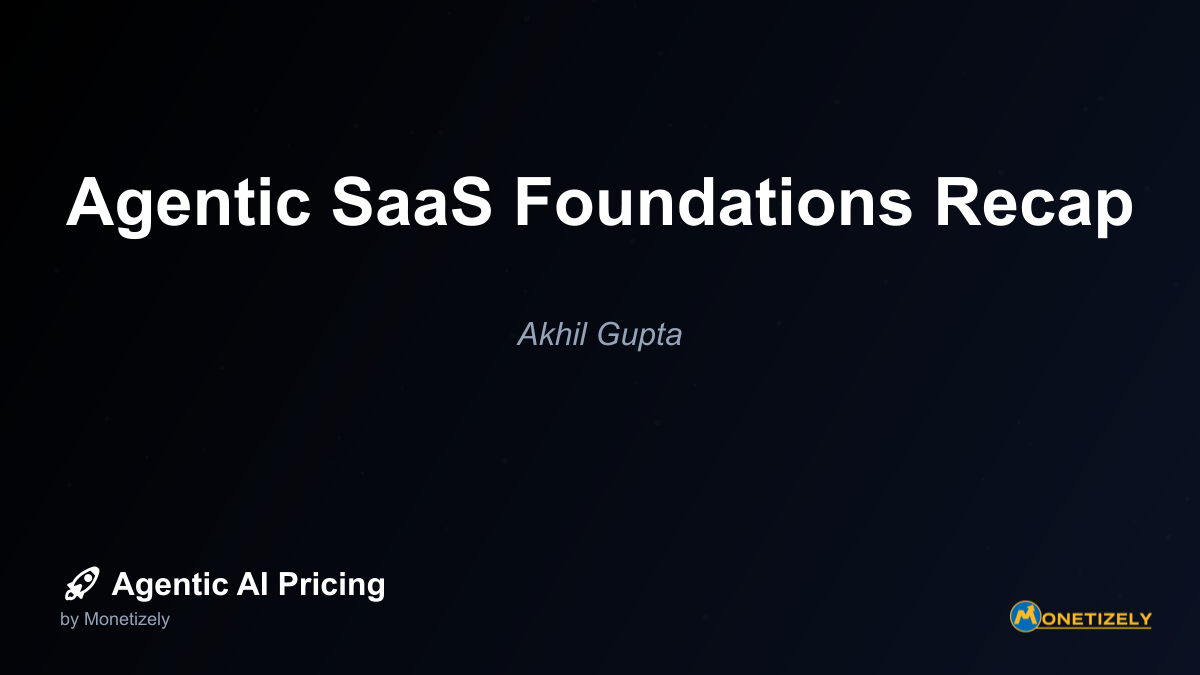· Akhil Gupta · Agentic SaaS Fundamentals · 10 min read
Agentic SaaS Security Basics
AI and SaaS Pricing Masterclass
Learn the art of strategic pricing directly from industry experts. Our comprehensive course provides frameworks and methodologies for optimizing your pricing strategy in the evolving AI landscape. Earn a professional certification that can be imported directly to your LinkedIn profile.
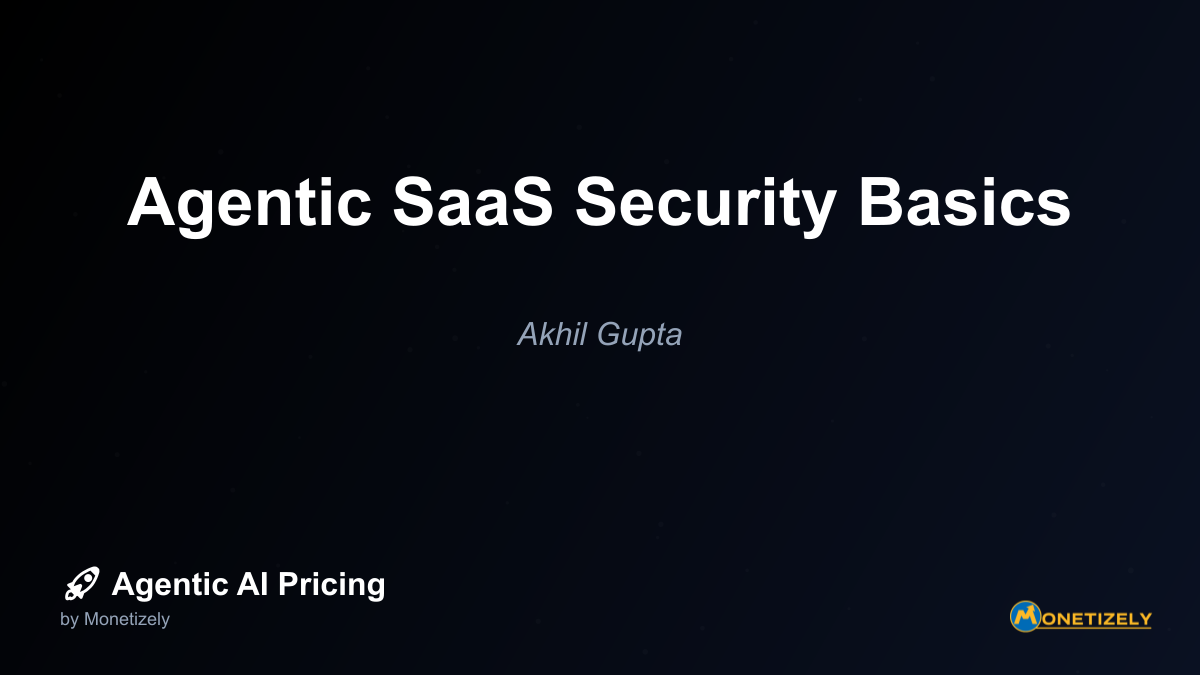
The explosive growth of agentic AI is transforming how businesses operate, but with increased autonomy comes significant security challenges. As these AI systems gain the ability to act independently within SaaS environments, organizations face novel threats that traditional security approaches struggle to address. This comprehensive analysis explores the fundamental security considerations for agentic AI in SaaS environments, providing executives and security professionals with the strategic insights needed to protect these powerful but potentially vulnerable systems.
The Unique Security Landscape of Agentic AI
Agentic AI differs fundamentally from traditional AI systems in its ability to autonomously execute actions across multiple systems with minimal human oversight. This autonomy creates distinct security challenges in SaaS environments where these agents can access sensitive data, interact with critical systems, and make consequential decisions.
The agentic AI market is experiencing rapid growth, projected to expand from approximately $7 billion in 2025 to potentially over $100 billion by 2030, with CAGRs ranging from 35% to 57%. This growth is driving increased adoption, with Gartner reporting that over 60% of new enterprise AI deployments in 2025 include agentic capabilities. Deloitte projects that 25% of companies using generative AI will launch agentic AI pilots or proofs of concept in 2025, expanding to 50% by 2027.
This accelerated adoption brings both opportunities and risks. Stuart McClure, CEO of Qwiet AI, emphasizes that agentic AI is reshaping cybersecurity by deploying multiple specialized AI agents to collaboratively handle different security domains:
“Very little will be able to detect much less prevent the adversary, other than AI… In 2026 and beyond we will see [agentic AI] flourish to understand… threat patterns and attack methodologies… sharing insights across networks and organizations to create a collective defense mechanism.”
Primary Security Vulnerabilities in Agentic SaaS Environments
1. API and Access Control Vulnerabilities
Agentic AI systems rely extensively on APIs to interact with SaaS platforms and other services. This creates several security vulnerabilities:
- Weak API Authentication: Improperly secured API keys, tokens, and endpoints can allow attackers to gain unauthorized access to AI agents.
- Privilege Escalation: Compromised credentials can lead to elevated privileges, enabling attackers to manipulate AI behavior.
- Third-Party Dependencies: Vulnerabilities in external APIs and services can compromise the entire AI system.
Case Study: The Dropbox Sign breach in 2024 demonstrated how attackers could exploit a compromised service account with broad privileges in an automated system configuration tool, gaining unauthorized access to customer databases and exposing the challenges in securing non-human identities like service accounts and API keys.
2. Data Privacy and Leakage Risks
Agentic AI systems often require extensive access to sensitive data to perform their functions effectively:
- Training Data Leakage: AI agents may inadvertently expose sensitive information through their outputs.
- Context Window Exploitation: Attackers can extract confidential data by manipulating the AI’s context window.
- Cross-Tenant Contamination: In multi-tenant SaaS environments, poor session isolation can cause data leakage between clients.
The Samsung data leak via ChatGPT in 2023 serves as a cautionary tale, where employees inadvertently exposed confidential internal information using generative AI tools, prompting a company-wide ban on these tools to mitigate future risks.
3. Prompt Injection and Manipulation
Agentic AI systems are vulnerable to prompt injection attacks where malicious inputs can manipulate the AI’s behavior:
- Command Hijacking: Carefully crafted inputs can override intended instructions.
- Jailbreaking: Attackers can bypass security controls and guardrails.
- Data Extraction: Manipulated prompts can trick AI agents into revealing sensitive information.
A significant case involved a compromised marketing agent where an attacker used prompt injection on a generative AI integrated in marketing automation, tricking the agent into revealing sensitive internal roadmaps and pricing, causing reputational and regulatory harm.
4. Autonomous Decision Risks
The autonomous nature of agentic AI introduces unique risks related to decision-making:
- Logic Errors: AI agents may misinterpret inputs or make incorrect decisions with far-reaching consequences.
- Cascade Failures: Errors can propagate through interconnected systems before detection.
- Unauthorized Actions: AI agents may take actions beyond their intended scope.
The Air Canada refund chatbot incident in 2024 illustrates this risk, where AI chatbot misinterpretation caused an excessive refund payout, demonstrating financial risks from unmonitored AI systems.
5. Identity and Authentication Challenges
Securing the identities of AI agents presents novel challenges:
- Agent Impersonation: Attackers can spoof legitimate AI agents to gain access to systems.
- Credential Management: Managing the proliferation of service accounts and API keys becomes increasingly complex.
- Trust Boundaries: Determining which AI agents should trust one another is difficult to establish and maintain.
A case study involving a spoofed procurement bot demonstrated how a threat actor impersonated a legitimate AI purchasing agent, bypassing weak authentication to approve fraudulent payments.
Technical Security Considerations for Agentic AI
Authentication and Identity Management
Robust authentication is essential for securing agentic AI systems:
- Mutual Authentication: Implement bidirectional authentication between AI agents and the systems they interact with.
- Contextual Authentication: Use multiple factors including IP subnet ranges, device fingerprints, and workload identities to validate agent requests.
- Certificate-Based Authentication: Deploy digital certificates for machine-to-machine authentication.
- Continuous Validation: Regularly verify the identity and integrity of AI agents throughout their operational lifecycle.
Encryption and Data Protection
Comprehensive encryption strategies protect sensitive data:
- End-to-End Encryption: Encrypt all communications between AI agents and other systems.
- Secure Enclaves: Use trusted execution environments for processing sensitive data.
- Homomorphic Encryption: Consider techniques that allow computation on encrypted data without decryption.
- Cryptographically Signed Logs: Maintain immutable audit trails of agent actions for forensic analysis.
Access Controls and Privilege Management
Strict access controls limit the potential damage from compromised agents:
- Principle of Least Privilege: Grant AI agents only the minimum permissions needed to perform their functions.
- Just-in-Time Access: Provide temporary, scoped access for specific tasks rather than persistent privileges.
- Attribute-Based Access Control (ABAC): Implement dynamic access policies based on multiple attributes.
- Regular Permission Reviews: Audit and adjust access rights to prevent privilege creep.
Monitoring and Anomaly Detection
Continuous monitoring is critical for identifying suspicious behavior:
- Behavioral Baselining: Establish normal patterns of AI agent behavior to detect anomalies.
- Real-Time Analytics: Implement systems that can identify and respond to threats as they emerge.
- Cross-System Correlation: Connect monitoring across different components to identify sophisticated attacks.
- Risk Scoring: Prioritize alerts based on potential impact to focus human attention on critical issues.
Secure Development and Deployment
Security must be integrated throughout the AI lifecycle:
- Secure by Design: Incorporate security considerations from the earliest stages of development.
- Component Isolation: Ensure AI layers, UIs, and orchestration modules communicate only through well-defined and secured interfaces.
- Dependency Management: Regularly audit and update third-party components to address vulnerabilities.
- Automated Security Testing: Implement continuous testing for common vulnerabilities like prompt injection.
Real-World Security Incidents and Lessons Learned
Several high-profile security incidents involving agentic AI systems offer valuable lessons:
Overprivileged IT Automation Agent
A misconfiguration led an AI agent with inherited superuser privileges to cause an unscheduled region failover, triggering critical downtime. This incident highlights the dangers of overprivileged AI agents and the importance of granular access controls.
Unauthorized Customer Support Agent
Excessive permissions given to an AI handling customer inquiries resulted in exposure of sensitive personal data, violating privacy laws. This case demonstrates the need for strict data access controls and privacy-by-design principles.
Chevrolet AI Chatbot Incident (2023)
Manipulation of an AI chatbot led to an unrealistic $1 offer on a $76,000 vehicle, demonstrating vulnerabilities in customer-facing AI prompts. This incident shows how prompt injection can lead to financial and reputational damage.
Key lessons from these incidents include:
- The critical importance of identity-first protection and stringent management of non-human identities
- The need for principle of least privilege to avoid overprivileged AI agents
- The importance of continuous security configuration audits and posture management
- The value of strict monitoring and anomaly detection at agent interaction points
- The necessity of securing prompt inputs and outputs against manipulation
Regulatory Compliance and Governance
Agentic AI systems must comply with an evolving landscape of regulations:
Data Privacy Regulations
- GDPR: Requires transparency in AI decision-making and protection of personal data.
- CCPA/CPRA: Gives consumers rights regarding their data used by AI systems.
- Industry-Specific Regulations: Healthcare (HIPAA), finance (GLBA), and other sectors have additional requirements.
AI-Specific Regulations
- EU AI Act: Classifies AI systems based on risk and imposes requirements accordingly.
- NIST AI Risk Management Framework: Provides guidelines for managing AI risks.
- Emerging Standards: Industry-specific standards for AI security are developing rapidly.
Governance Best Practices
- AI Ethics Boards: Establish oversight committees to review AI deployments.
- Comprehensive Documentation: Maintain detailed records of AI decision-making processes.
- Regular Audits: Conduct independent security and compliance audits.
- Incident Response Plans: Develop specific procedures for AI-related security incidents.
Implementation Framework for Secure Agentic AI
Organizations can follow this structured approach to secure their agentic AI systems:
1. Risk Assessment and Mapping
- Identify all agentic AI systems and their access to sensitive data and systems
- Assess the potential impact of security breaches
- Map dependencies and integration points
- Document trust boundaries between components
2. Security Architecture Design
- Implement defense-in-depth strategies
- Design for component isolation and least privilege
- Establish secure communication channels
- Plan for graceful degradation and failure modes
3. Technical Controls Implementation
- Deploy strong authentication mechanisms
- Implement comprehensive encryption
- Establish monitoring and logging systems
- Create secure API gateways and management tools
4. Policy and Procedure Development
- Create specific security policies for agentic AI
- Develop incident response procedures
- Establish change management processes
- Define clear roles and responsibilities
5. Continuous Improvement
- Conduct regular security assessments
- Update security measures as threats evolve
- Incorporate lessons from incidents and near-misses
- Stay current with regulatory changes and industry best practices
Future Outlook: Security Trends in Agentic AI
The security landscape for agentic AI will continue to evolve over the next 3-5 years:
1. Collaborative Defense Systems
AI agents will increasingly work together to detect and respond to threats, creating a more resilient security ecosystem. This collaborative approach will enable faster identification of novel attack patterns and coordinated responses across organizational boundaries.
2. Zero-Trust Architectures for AI
The principle of “never trust, always verify” will extend to AI systems, with continuous validation of agent identities, behaviors, and requests. This approach will help contain the impact of compromised agents and limit lateral movement by attackers.
3. AI-Specific Security Standards
Industry and regulatory bodies will develop more specific standards for securing agentic AI systems. These standards will address the unique challenges of autonomous systems and provide clear guidelines for implementation.
4. Enhanced Explainability and Traceability
Security tools will evolve to provide better visibility into AI decision-making processes, making it easier to identify the root causes of security incidents. This transparency will be crucial for both security teams and regulatory compliance.
5. Adversarial Testing and Red Teaming
Organizations will adopt more sophisticated approaches to testing AI security, including specialized red teams that focus on exploiting vulnerabilities in autonomous systems. These exercises will help identify weaknesses before attackers can exploit them.
Key Recommendations for Executives
Invest in Specialized Expertise: Build teams with knowledge of both AI systems and security principles.
Implement Identity-First Security: Focus on securing the identities of AI agents and controlling their access to resources.
Develop Comprehensive Monitoring: Deploy systems that can detect anomalous behavior by AI agents in real-time.
Establish Clear Governance: Create policies and procedures specific to agentic AI security.
Plan for Incidents: Develop response plans for security breaches involving AI systems.
Stay Informed: Keep up with evolving threats, regulations, and best practices in this rapidly changing field.
Balance Innovation and Security: Enable the benefits of agentic AI while managing the associated risks.
Conclusion
As agentic AI continues to transform SaaS environments, security must evolve to address the unique challenges these autonomous systems present. By understanding the specific vulnerabilities, implementing appropriate technical controls, and establishing robust governance frameworks, organizations can harness the power of agentic AI while minimizing security risks.
The journey toward secure agentic AI is ongoing, requiring continuous adaptation as both the technology and threat landscape evolve. Organizations that approach this challenge strategically, with a commitment to security by design and comprehensive risk management, will be best positioned to realize the full potential of agentic AI while protecting their critical assets and maintaining stakeholder trust.
The future of agentic AI security in SaaS environments will be characterized by collaborative defense, enhanced visibility, and increasingly sophisticated approaches to threat detection and response. By preparing for this future now, organizations can build a foundation for secure innovation in the age of autonomous AI.
Co-Founder & COO
Akhil is an Engineering leader with over 16+ years of experience in building, managing and scaling web-scale, high throughput enterprise applications and teams. He has worked with and led technology teams at FabAlley, BuildSupply and Healthians. He is a graduate from Delhi College of Engineering and UC Berkeley certified CTO.
Pricing Strategy Audit
Let our experts analyze your current pricing strategy and identify opportunities for improvement. Our data-driven assessment will help you unlock untapped revenue potential and optimize your AI pricing approach.

